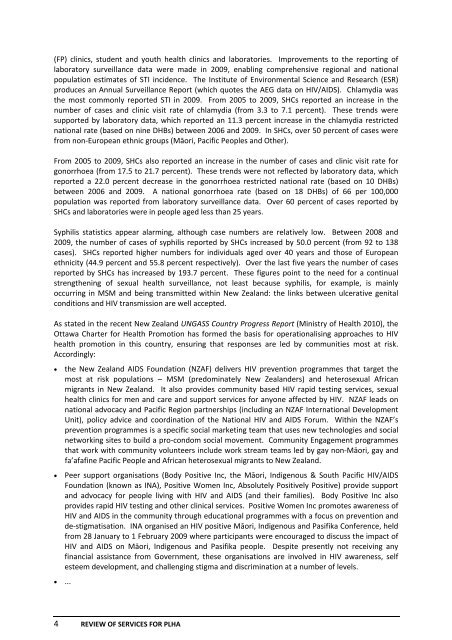Review of services for people living with HIV in New Zealand
Review of services for people living with HIV in New Zealand
Review of services for people living with HIV in New Zealand
- No tags were found...
You also want an ePaper? Increase the reach of your titles
YUMPU automatically turns print PDFs into web optimized ePapers that Google loves.
(FP) cl<strong>in</strong>ics, student and youth health cl<strong>in</strong>ics and laboratories. Improvements to the report<strong>in</strong>g <strong>of</strong>laboratory surveillance data were made <strong>in</strong> 2009, enabl<strong>in</strong>g comprehensive regional and nationalpopulation estimates <strong>of</strong> STI <strong>in</strong>cidence. The Institute <strong>of</strong> Environmental Science and Research (ESR)produces an Annual Surveillance Report (which quotes the AEG data on <strong>HIV</strong>/AIDS). Chlamydia wasthe most commonly reported STI <strong>in</strong> 2009. From 2005 to 2009, SHCs reported an <strong>in</strong>crease <strong>in</strong> thenumber <strong>of</strong> cases and cl<strong>in</strong>ic visit rate <strong>of</strong> chlamydia (from 3.3 to 7.1 percent). These trends weresupported by laboratory data, which reported an 11.3 percent <strong>in</strong>crease <strong>in</strong> the chlamydia restrictednational rate (based on n<strong>in</strong>e DHBs) between 2006 and 2009. In SHCs, over 50 percent <strong>of</strong> cases werefrom non‐European ethnic groups (Māori, Pacific Peoples and Other).From 2005 to 2009, SHCs also reported an <strong>in</strong>crease <strong>in</strong> the number <strong>of</strong> cases and cl<strong>in</strong>ic visit rate <strong>for</strong>gonorrhoea (from 17.5 to 21.7 percent). These trends were not reflected by laboratory data, whichreported a 22.0 percent decrease <strong>in</strong> the gonorrhoea restricted national rate (based on 10 DHBs)between 2006 and 2009. A national gonorrhoea rate (based on 18 DHBs) <strong>of</strong> 66 per 100,000population was reported from laboratory surveillance data. Over 60 percent <strong>of</strong> cases reported bySHCs and laboratories were <strong>in</strong> <strong>people</strong> aged less than 25 years.Syphilis statistics appear alarm<strong>in</strong>g, although case numbers are relatively low. Between 2008 and2009, the number <strong>of</strong> cases <strong>of</strong> syphilis reported by SHCs <strong>in</strong>creased by 50.0 percent (from 92 to 138cases). SHCs reported higher numbers <strong>for</strong> <strong>in</strong>dividuals aged over 40 years and those <strong>of</strong> Europeanethnicity (44.9 percent and 55.8 percent respectively). Over the last five years the number <strong>of</strong> casesreported by SHCs has <strong>in</strong>creased by 193.7 percent. These figures po<strong>in</strong>t to the need <strong>for</strong> a cont<strong>in</strong>ualstrengthen<strong>in</strong>g <strong>of</strong> sexual health surveillance, not least because syphilis, <strong>for</strong> example, is ma<strong>in</strong>lyoccurr<strong>in</strong>g <strong>in</strong> MSM and be<strong>in</strong>g transmitted <strong>with</strong><strong>in</strong> <strong>New</strong> <strong>Zealand</strong>: the l<strong>in</strong>ks between ulcerative genitalconditions and <strong>HIV</strong> transmission are well accepted.As stated <strong>in</strong> the recent <strong>New</strong> <strong>Zealand</strong> UNGASS Country Progress Report (M<strong>in</strong>istry <strong>of</strong> Health 2010), theOttawa Charter <strong>for</strong> Health Promotion has <strong>for</strong>med the basis <strong>for</strong> operationalis<strong>in</strong>g approaches to <strong>HIV</strong>health promotion <strong>in</strong> this country, ensur<strong>in</strong>g that responses are led by communities most at risk.Accord<strong>in</strong>gly: ...the <strong>New</strong> <strong>Zealand</strong> AIDS Foundation (NZAF) delivers <strong>HIV</strong> prevention programmes that target themost at risk populations – MSM (predom<strong>in</strong>ately <strong>New</strong> <strong>Zealand</strong>ers) and heterosexual Africanmigrants <strong>in</strong> <strong>New</strong> <strong>Zealand</strong>. It also provides community based <strong>HIV</strong> rapid test<strong>in</strong>g <strong>services</strong>, sexualhealth cl<strong>in</strong>ics <strong>for</strong> men and care and support <strong>services</strong> <strong>for</strong> anyone affected by <strong>HIV</strong>. NZAF leads onnational advocacy and Pacific Region partnerships (<strong>in</strong>clud<strong>in</strong>g an NZAF International DevelopmentUnit), policy advice and coord<strong>in</strong>ation <strong>of</strong> the National <strong>HIV</strong> and AIDS Forum. With<strong>in</strong> the NZAF’sprevention programmes is a specific social market<strong>in</strong>g team that uses new technologies and socialnetwork<strong>in</strong>g sites to build a pro‐condom social movement. Community Engagement programmesthat work <strong>with</strong> community volunteers <strong>in</strong>clude work stream teams led by gay non‐Māori, gay andfa’afaf<strong>in</strong>e Pacific People and African heterosexual migrants to <strong>New</strong> <strong>Zealand</strong>.Peer support organisations (Body Positive Inc, the Māori, Indigenous & South Pacific <strong>HIV</strong>/AIDSFoundation (known as INA), Positive Women Inc, Absolutely Positively Positive) provide supportand advocacy <strong>for</strong> <strong>people</strong> <strong>liv<strong>in</strong>g</strong> <strong>with</strong> <strong>HIV</strong> and AIDS (and their families). Body Positive Inc alsoprovides rapid <strong>HIV</strong> test<strong>in</strong>g and other cl<strong>in</strong>ical <strong>services</strong>. Positive Women Inc promotes awareness <strong>of</strong><strong>HIV</strong> and AIDS <strong>in</strong> the community through educational programmes <strong>with</strong> a focus on prevention andde‐stigmatisation. INA organised an <strong>HIV</strong> positive Māori, Indigenous and Pasifika Conference, heldfrom 28 January to 1 February 2009 where participants were encouraged to discuss the impact <strong>of</strong><strong>HIV</strong> and AIDS on Māori, Indigenous and Pasifika <strong>people</strong>. Despite presently not receiv<strong>in</strong>g anyf<strong>in</strong>ancial assistance from Government, these organisations are <strong>in</strong>volved <strong>in</strong> <strong>HIV</strong> awareness, selfesteem development, and challeng<strong>in</strong>g stigma and discrim<strong>in</strong>ation at a number <strong>of</strong> levels.4 REVIEW OF SERVICES FOR PLHA
















